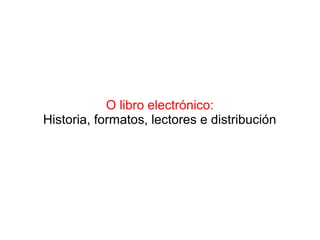Historia do ebook
•Transferir como ODP, PDF•
0 gostou•630 visualizações
Historia do ebook: 1971-2010
Denunciar
Compartilhar
Denunciar
Compartilhar

Recomendados
Recomendados
Mais conteúdo relacionado
Destaque
Destaque (20)
How Race, Age and Gender Shape Attitudes Towards Mental Health

How Race, Age and Gender Shape Attitudes Towards Mental Health
AI Trends in Creative Operations 2024 by Artwork Flow.pdf

AI Trends in Creative Operations 2024 by Artwork Flow.pdf
Content Methodology: A Best Practices Report (Webinar)

Content Methodology: A Best Practices Report (Webinar)
How to Prepare For a Successful Job Search for 2024

How to Prepare For a Successful Job Search for 2024
Social Media Marketing Trends 2024 // The Global Indie Insights

Social Media Marketing Trends 2024 // The Global Indie Insights
Trends In Paid Search: Navigating The Digital Landscape In 2024

Trends In Paid Search: Navigating The Digital Landscape In 2024
5 Public speaking tips from TED - Visualized summary

5 Public speaking tips from TED - Visualized summary
Google's Just Not That Into You: Understanding Core Updates & Search Intent

Google's Just Not That Into You: Understanding Core Updates & Search Intent
The six step guide to practical project management

The six step guide to practical project management
Beginners Guide to TikTok for Search - Rachel Pearson - We are Tilt __ Bright...

Beginners Guide to TikTok for Search - Rachel Pearson - We are Tilt __ Bright...
Unlocking the Power of ChatGPT and AI in Testing - A Real-World Look, present...

Unlocking the Power of ChatGPT and AI in Testing - A Real-World Look, present...
Historia do ebook
- 1. O libro electrónico: Historia, formatos, lectores e distribución
- 2. Michael Hart Proxecto Gutenberg "Consideramos o texto electrónico como un novo medio de comunicación, sen verdadeira relación co papel. A única semellanza é que distribuímos as mesmas obras, pero en canto a xente se teña acostumado, non vexo como o papel aínda podería competir co texto electrónico, sobre todo nas escolas."
- 4. Desenvólvese internet e Tim Berners-Lee concibe a web desde o CERN
- 5. En 1989 Tim Berners-Lee pon na rede os primeiros documentos con Hipertexto. En 1990 crea o 1º servidor http e o primeiro navegador. A información vólvese interactiva. A (rede) www é xa unha realidade.
- 7. Nace o formato PDF
- 8. Relatos breves, e-zines, primeiras Revistas, novelas por email...
- 10. As bibliotecas instálanse na web. 1994 Biblioteca pública de Helsinki Dixitalización: Imaxe = faccsímil OCR = texto
- 11. Acrobat eBook Reader DRM, notas, marcadores, Adobe LiveCycle Policy Server
- 12. PDF para Adobe Reader LIT para Microsoft Reader PRC para Mobipocket Reader OeB precursor do ePub eLibrarías Amazon, Barnes & Noble, Yahoo! eBook Store, Random House, PerfectBound, Numilog, Mobipocket, Palm Digital Media
- 13. despegue dos blogues = democratización das páxinas web Todas/os podemos nova canle para a distribución novo medio para a produción novos esquemas de narración interactividade, participación, colaboración
- 14. IDPF: International Digital Publishing Forum. Nace co propósito de desenvolver o formato EPUB, baseado en XML e susceptíbel de admitir DRM. EPUB MOBIPOCKET Amazon compra Mobipocket, Formato e software específicos para PDAs
- 15. Nace Google Books, un proxecto que parte de 2004. Biblioteca, bilbioteca de bibliotecas e libraría libros na nube
- 16. Amazon lanza o Kindle Catálogo inicial: 80.000 títulos
- 20. Ebooks en cifras Obras libres de dereitos Google: 13.000.000 Internet Archive [moitos proveñen de Google]: 2.500.000 Hathi Trust [moitos proveñen de Google: 1.583.000 Biblioteca Virtual Miguel de Cervantes: 60.000 Proyecto Gutenberg: 33.000 Kindle: 30.000 Biblioteca Digital Hispánica:14.000 El Aleph: 3.600
- 21. Ebooks en cifras Obras con copyright vigente Google por acordo con editores: 2.000.000 Kindle: 670.000 Lulu (distintas linguas, non autopublicación): 200.000 Laie: 124.000 E-libro.com (para bibliotecas, en español): 38.000 iBook (para iPhone o iPad): 30.000 BuBok (autopublicación): 30.000 Publidisa: 25.000 P2P en castelán: 25.000 Grammata: 23.000 [comprende tamén libros sen dereitos] Libros en “edición electrónica” editados en España no primeiro semestre de 2010: 9.546 Libros que alcanzará Libranda este ano: 4.000-5.000 Biblioteca Digital Hispánica, da Biblioteca Nacional de España, a través de Enclave: 3.300 Lulu (autopublicación en castelán): 2.885 Edi.cat: 2.400 [1.700 de Libranda, e o resto entre Edi.cat e EdiBooks] E-libro.net [en español]: 2.000 Fonte: Libros y bitios
- 22. Una breve historia del libro electrónico Marie Lebert
- 23. Moitas grazas tatimancebo@blogaliza.org http://tatimancebo.blogaliza.org Historia do ebook en SlideShare